Chances are that the label on your favorite bore cleaner says something about “removing lead.” Being the curious guy that I am, I began to wonder just exactly how bore cleaners manage to accomplish this trick. Lead is a pretty inert metal, and there isn’t much that can actually dissolve it. So just how does bore cleaner get rid of lead fouling in a barrel?
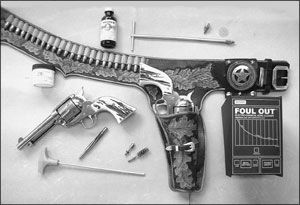
If we think about it, there are only a few ways to remove lead from a barrel. We could melt it out with a torch, but no one would want to take a torch to a favorite firearm. The three other ways to remove the offending metal are: (1) to penetrate under the lead to separate its bond with the barrel so that it can be pushed out, (2) use an abrasive to actually scour it away, or (3) to somehow break it down chemically. Some old-timers have also told me that pouring mercury in the bore would remove lead, but since mercury is poisonous and can drive those who are overexposed to it insane, I think we can skip that method.
Actually, each of the three other methods are commonly used, but I thought it would be interesting to look at each method and weigh the cost against the work necessary to clean the firearm. The traditional and most common methods use a combination of penetration and abrasion; in other words, the bore cleaner acts to loosen the lead and the bore brush scrubs it away. This is an effective method and has been used successfully for many years, but it can be labor intensive on a badly leaded bore and almost totally ineffective on a rough bore. A newer method is an electronic system called the Foul Out, introduced by Outers several years ago. It breaks down lead electro-chemically and deposits it on a rod placed in the bore. As you can imagine, the cost and complexity varies quite a bit from the simplest to the most advanced of these methods. Thus, I thought it would be interesting to see how effective each method is.
My wife and I competed all last summer in cowboy-action shoots. Each of us shot a pair of stainless Ruger Vaqueros with commercially cast lead bullets. In order to experiment with the lead-removal methods, we didn’t clean the guns all season. (Oh, the things we do in the name of science!) The result was four filthy guns with heavily leaded barrels, perfect for my experiments.
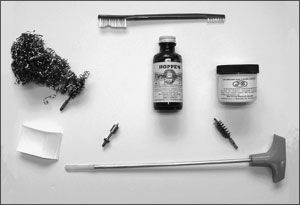
To establish a standard, I cleaned the first gun in the traditional manner using Hoppe’s #9. This product is still very popular despite the many competitors that have flooded the market, and it is still the old standby that most of us are familiar with. After saturating a patch and pushing it down the bore, I let it sit for 20 minutes to penetrate under the lead. I then attacked the bore with a new bronze bore brush and lots of elbow grease. A few bright specs of lead came out of the bore, and then it seems I hit a wall where no amount of scrubbing seemed to produce any further result. I repeated the process five times until the bore was visibly clean and patches came out clean. I then plugged the breech end of the bore, filled it with the Foul Out solution, and plugged the unit in. The Foul Out system proclaimed the gun “clean,” and the first test was completed. Total time was one hour, 45 minutes of sweat and elbow grease (and the cylinder and the rest of the gun were still waiting for my attention). However, the cost was nothing beyond that of the cleaning materials I had on hand, and this appealed to my frugal nature.
For the second gun, I used the Lewis Lead Remover. This is a product that has been around for many years, consisting of a T-rod, a cone-shaped end for cleaning the forcing cone, and an expandable plug that accepts a brass screen. To use the tool, you put the rod down the bore from the muzzle end with the cylinder removed. You place the brass screen and expandable rubber plug on the end of the rod, and expand the rubber until you have a tight fit in the bore. By pulling the brass screen through the bore, the lead becomes embedded in the screen and is pulled out of the bore. The process is simple and extremely effective. Lewis Lead Removers come as caliber-specific sets (Brownells) for around $25, and replacement brass screens are about $3 per package of 10. I made four passes through the bore and pulled large quantities of lead out on the first three. The fourth pass produced very little lead, and on the fifth pass the brass screen patch was completely clean. After a quick swab with a patch soaked in bore cleaner and a few dry patches, I was done. Once again, I hooked the gun up to the Foul Out system and found it to be completely lead free. The total time to delead the barrel was less than 10 minutes. The additional cost was roughly $25.
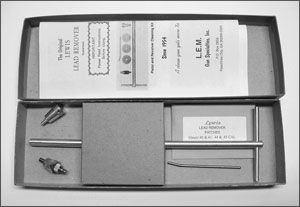
For the third gun, I went straight to the Outers Foul Out system. My system is a first-generation system and is not as fast or as efficient as the third-generation systems on the market today. It is still, however, extremely effective at removing lead or copper-jacket fouling from any firearm. The current Foul Out 3 system comes with the steel rod (electrode), control unit, AC adapter, bore plugs, O-rings, and both Lead Out and Cop Out solutions. The price ranges from less than $85 (Midway USA) to about $125 from other sources. To use this unique system, you to put a rubber plug in the bore and then hold the gun in an upright position. The rubber O-rings are placed on the steel rod to keep the rod from coming in contact with the bore, and the rod is placed in the bore from the muzzle end. The bore is then filled with either Lead Out solution, as I did in this case, or Cop out solution if you are removing bullet-jacket fouling from a rifle or pistol barrel. The control unit is attached, plugged in, and turned on, and then you can work on another project while the unit cleans the gun. In my case, the leading was so heavy that when I checked it the first time the steel rod was so full of lead it had overloaded the system. I removed the rod, wiped the lead off, put it back in the bore, and let it go back to work. Shortly thereafter, it had pulled enough lead off the barrel to overload the system again, so I wiped the lead from the rod again and put it back in the bore to finish the job. The next time I checked it, the unit indicated that the gun was clean. Removing the rod, draining the solution, and removing the bore plug showed a chemically cleaned barrel without a trace of lead. Total time was 45 minutes—and I spent most of that watching TV. This is by far the least labor-intensive lead-removing system I’ve ever used, but at a price of $85 it is also the most expensive.
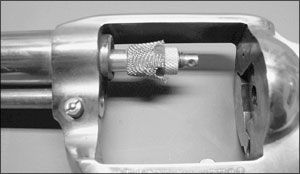
Once the barrels were clean, that left some very dirty cylinders to take care of. There are several products on the market that will clean them, but I’ve found the fastest and most effective for removing lead is a cylinder-deleading reamer. Available from Brownells, these are quick and easy to use by simply inserting them into the back of the cylinder and turning them by hand. They are made to SAMMI specs and will cut the lead cleanly out of the cylinder. One word of caution is in order here: Keep in mind that these are reamers made to cut. I suggest turning them by hand and stopping once they stop cutting. If you drive them with a power tool and can’t feel when they stop cutting, it’s possible to cut steel as well as lead with them. Made by both Manson and Clymer, they retail for around $50.
The remainder of the cleaning chores were handled in the normal manner and proceeded without incident. Overall, each of the methods discussed has good and bad points, and like most things in life there is some tradeoff. The solvent-and-brush method is by far the slowest and most labor intensive, but the end result is as good as the most expensive and sophisticated method, and the cost is almost negligible.
The Lewis Lead Remover was the fastest method, and again produced a result as good as the Foul Out. For a price of around $25, it’s reasonably affordable and not too labor-intensive. Its one weak point is the attachment of the brass screen. The screen is sandwiched between the end of the rod and the caliber-specific rubber plug with a very small contact area. This requires that it be tightened down very snugly or it will simply tear out. A caliber-specific rod would ensure a larger contact area in the bigger calibers and extend the life of the brass screens, but unfortunately the same diameter rod comes with all the kits, presumably to keep the cost down.
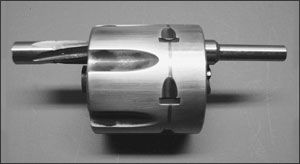
The aluminum cone-shaped forcing-cone cleaner is also available in only one angle, and I found that the angle did not match that on my Rugers. This meant that it cleaned one spot on the forcing cone but was not in contact with the entire surface of the cone. Don’t misunderstand me; I think this is a good product, but it seems that nobody has taken the time to update it as guns have changed over the years.
Last we have Outers Foul Out system. It is easily the least labor intensive of the three methods, and the one that actually tells you when you’re done. Anything that works while I watch TV gets my vote, but it is also the most expensive system. For the extra money, you get a system that is as effective on copper fouling as it is on lead, and one that will work on rifles as well as pistols. I never thought cleaning guns could be so easy.
To sum up, solvent and brush is cheapest. the Lewis Lead Remover is fastest, and the Foul Out system is the easiest. From there it’s your decision. Personally, I vote for the Foul Out. Now, where did I put that TV Guide? I have another gun to clean.































Let’s Go Brandon!